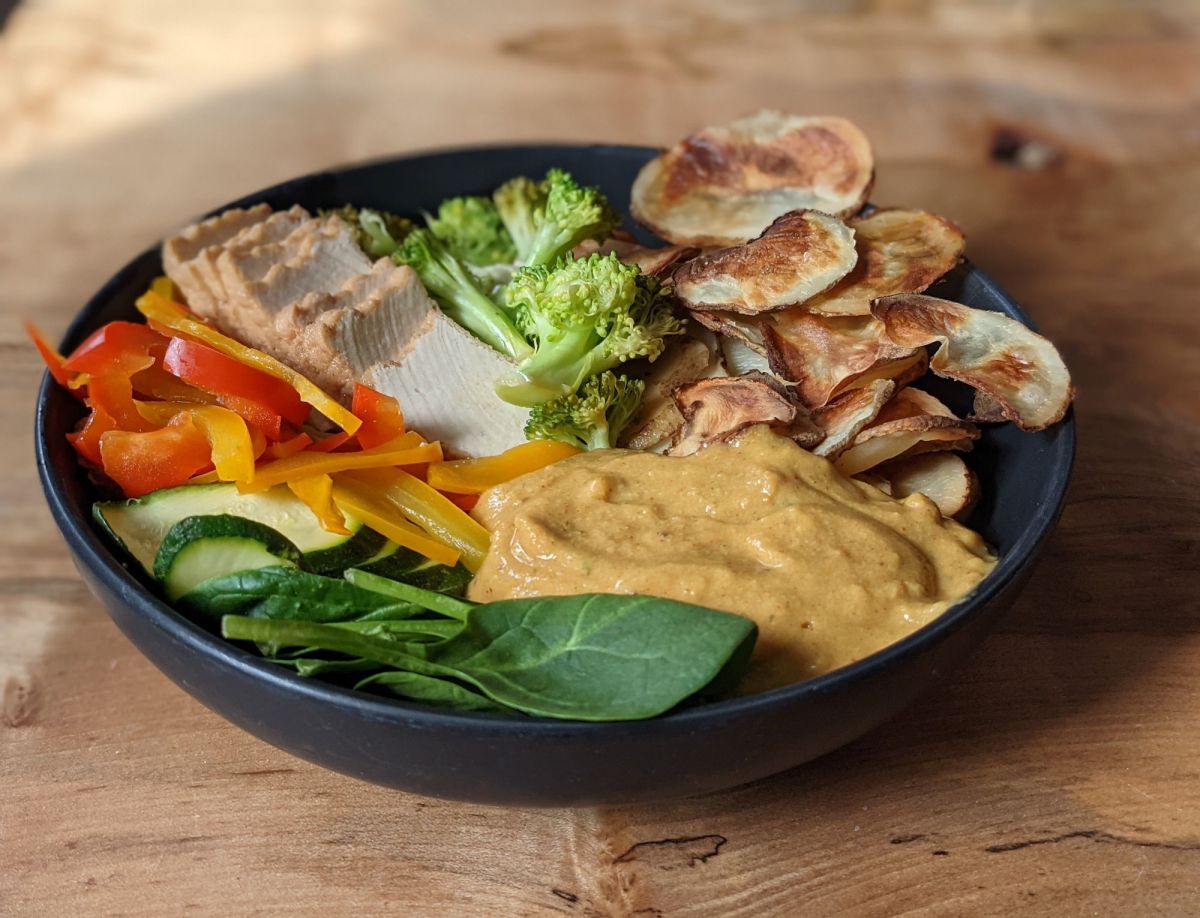Transform ordinary vegetables into extraordinary snacks with this comprehensive guide to creating homemade vegetarian chips and dips. Imagine the vibrant colors: crisp, golden-brown chips nestled beside creamy, flavorful dips, each bite a burst of texture and taste. We’ll explore diverse vegetable choices, mastering various cooking techniques to achieve perfect crispness. From simple sweet potato chips to richly flavored dips, this journey promises a delicious and satisfying culinary adventure.
This guide unveils the secrets to crafting a stunning array of vegetarian chips and dips, perfect for parties, gatherings, or a simple weeknight treat. We’ll cover everything from selecting and preparing vegetables for optimal texture to mastering diverse cooking methods, ensuring perfectly crispy results every time. Get ready to explore creative dip recipes, ranging from creamy avocado-based options to zesty cilantro-lime creations, all designed to complement your homemade chips.
Vegetable Selection and Preparation
Creating delicious and visually appealing vegetarian chips starts with selecting the right vegetables and preparing them correctly. The choice of vegetable significantly impacts the final texture and flavor profile of your chips, while proper preparation ensures even cooking and optimal crispness.
Versatile Vegetables for Vegetarian Chips
The key to successful homemade chips lies in choosing vegetables that hold their shape well during cooking and offer a pleasing texture. Five excellent options are presented below, each with its ideal thickness for achieving that perfect crisp.
- Sweet Potatoes: These offer a naturally sweet flavor and a vibrant orange hue. Aim for 1/8-inch thick slices for even cooking and a tender-crisp texture.
- Beets: Beets provide an earthy sweetness and beautiful deep red color. Similar to sweet potatoes, a 1/8-inch thickness is ideal for achieving optimal crispness.
- Carrots: Carrots deliver a mild sweetness and a satisfying crunch. For carrots, slightly thinner slices, around 1/10-inch, work best to prevent them from becoming tough.
- Zucchini: Zucchini offers a delicate, slightly grassy flavor and a light texture. Aim for 1/4-inch slices to maintain their shape and prevent them from becoming overly soft.
- Potatoes (Russet or Yukon Gold): Classic potato chips offer a familiar taste and satisfying crunch. For russets, aim for 1/8-inch thickness. Yukon Golds can be slightly thicker, around 1/6-inch, due to their higher moisture content.
Vegetable Preparation Methods
Three distinct methods can be employed to prepare vegetables before baking or frying, each affecting the final texture and taste.
- Soaking in Cold Water: Soaking sliced vegetables in cold water for 30 minutes before cooking helps to remove excess starch, leading to crispier chips. This method is particularly beneficial for potatoes, reducing the likelihood of soggy chips.
- Patting Dry: Thoroughly patting the vegetables dry with paper towels after soaking or washing is crucial. Excess moisture hinders the crisping process, resulting in soft, less appealing chips. This step is vital regardless of the chosen cooking method.
- Pre-baking/Pre-frying: A preliminary baking or frying step at a lower temperature can help to remove some moisture before the main cooking stage. This technique enhances crispness, particularly for vegetables with higher water content like zucchini or certain types of potatoes. The pre-cooking should be done until slightly softened, not fully cooked.
Cutting Vegetables into Uniform Chips
Uniformly sized chips ensure even cooking and a consistent texture. Several kitchen tools can assist in achieving this.
- Mandoline Slicer: This tool allows for precise and consistent slicing, creating uniformly thin chips with ease. Adjust the thickness setting to achieve the desired chip thickness. Use the safety guard provided to prevent accidents.
- Vegetable Peeler: A vegetable peeler can be used to create long, thin strips of vegetables like zucchini or carrots. This method is ideal for creating rustic, thinner chips.
- Sharp Knife: A sharp knife allows for greater control and precision when cutting vegetables into various shapes, although it may require more time and skill to achieve uniformity. Practice makes perfect!
| Cutting Technique | Resulting Chip Aesthetics |
|---|---|
| Mandoline Slicer | Perfectly uniform, thin chips with consistent thickness and shape. |
| Vegetable Peeler | Long, thin, rustic-looking strips, ideal for certain vegetables. |
| Sharp Knife | Chips can vary slightly in size and thickness, but with practice, a high degree of uniformity can be achieved. |
Chip Cooking Methods
Transforming thinly sliced vegetables into crispy, flavorful chips requires careful consideration of the cooking method. Baking, air frying, and pan-frying each offer unique advantages and disadvantages, impacting both the final texture and the nutritional content of your homemade chips. The choice depends on your preferences for crispness, convenience, and the overall health profile of your snack.
Baking, air frying, and pan-frying offer distinct approaches to achieving perfectly crispy vegetable chips. Baking provides a consistent, even cook, ideal for delicate vegetables. Air frying utilizes rapid air circulation for a crispier result in less time, while pan-frying offers a quick, potentially more flavorful option, though it can require more attention and oil.
Baking
Baking offers a healthy and relatively hands-off approach to making vegetable chips. The even heat distribution ensures consistent crispness across the batch, minimizing burning. Optimal baking temperatures generally range from 375°F (190°C) to 400°F (200°C), with baking times varying depending on the vegetable type and thickness of the slices. Thinner slices will require shorter cooking times, typically between 15-25 minutes, while thicker slices may need 25-35 minutes, or even longer. Regular flipping halfway through ensures even browning and crispness. The lower temperatures used in baking compared to pan-frying help to retain more nutrients. Imagine the vibrant color of perfectly baked sweet potato chips, their edges delicately crisp, while the interior remains slightly tender.
Air Frying
Air frying leverages rapid air circulation to create incredibly crispy chips in a fraction of the time compared to baking. This method requires less oil, resulting in a healthier snack. The optimal temperature for air frying vegetable chips is typically between 375°F (190°C) and 400°F (200°C), with cooking times ranging from 10-20 minutes, depending on the vegetable and thickness of the slices. The key is to arrange the slices in a single layer to ensure even air circulation. Picture perfectly golden-brown chips, with a satisfying crunch that results from the air frying process, retaining more of the vegetables’ natural moisture.
Pan-Frying
Pan-frying provides a quick method for creating crispy chips, often resulting in a more intense flavor due to the contact with hot oil. However, it requires more attention and uses significantly more oil than baking or air frying. The oil temperature should be around 350°F (175°C) to 375°F (190°C). Cooking times are typically short, ranging from 3-7 minutes per side, depending on the vegetable and desired level of crispness. Frequent flipping is crucial to prevent burning. While pan-frying yields exceptionally crispy chips, it’s important to note the higher oil content, which impacts the overall nutritional profile compared to baking or air frying. Imagine the rich, golden-brown hue of the chips, with a delightful crispness and a subtle flavor infused from the oil.
Baked Sweet Potato Chips Recipe
This recipe demonstrates the ease and effectiveness of baking for creating delicious and healthy sweet potato chips.
- 1 large sweet potato (about 1 pound), peeled and thinly sliced (1/8 inch thick)
- 2 tablespoons olive oil
- 1/2 teaspoon sea salt
- 1/4 teaspoon black pepper
Preheat your oven to 400°F (200°C). Toss the sweet potato slices with olive oil, salt, and pepper, ensuring even coating. Arrange the slices in a single layer on a baking sheet lined with parchment paper. Bake for 20-25 minutes, flipping halfway through, until the chips are golden brown and crispy. The result: a beautiful batch of sweet potato chips, perfectly crisp on the outside and tender on the inside, showcasing the natural sweetness of the sweet potato.
Dip Recipes

Creamy dips are the perfect complement to homemade vegetable chips, offering a delightful balance of textures and flavors. The following recipes showcase the versatility of different base ingredients, resulting in healthy and delicious dips that are sure to impress. Each recipe emphasizes fresh, vibrant ingredients to enhance the overall sensory experience.
Avocado Cilantro Lime Dip
This vibrant green dip is incredibly simple to make, requiring minimal ingredients and preparation time. The creamy avocado base is brightened by the zesty lime juice and herbaceous cilantro, creating a refreshing and flavorful dip. Imagine the vibrant green of the avocado contrasting beautifully with the bright green of the cilantro, all punctuated by the almost luminous yellow of the lime juice. The texture is luxuriously smooth and creamy, almost melting in your mouth.
To prepare, simply combine one ripe avocado, 1/4 cup chopped cilantro, the juice of one lime, a pinch of salt, and a splash of water (to adjust consistency) in a food processor. Blend until completely smooth and creamy. Garnish with extra cilantro and a lime wedge for a touch of elegance.
Cashew-Based Creamy Spinach Artichoke Dip
This cashew-based dip offers a luxuriously creamy texture without the heaviness of traditional cream cheese-based dips. The earthy spinach and tangy artichoke hearts perfectly complement the rich cashew cream, creating a complex and satisfying flavor profile. Picture a pale, creamy green dip, flecked with the dark green of spinach and the pale yellow of artichoke hearts. The texture is rich and decadent, yet surprisingly light.
To begin, soak 1 cup raw cashews in hot water for at least 30 minutes to soften. Drain and blend with 1 cup packed spinach, 1 cup chopped artichoke hearts, 2 cloves garlic, 2 tablespoons lemon juice, 1/4 cup water, and salt to taste until smooth and creamy. Adjust the consistency with more water as needed.
Greek Yogurt Cucumber Dill Dip
This light and refreshing dip is a perfect example of healthy indulgence. The tangy Greek yogurt provides a creamy base, while the cool cucumber and fragrant dill create a bright and herbaceous flavor combination. Visualize a pale, almost translucent white dip, punctuated by the bright green of the finely diced cucumber and the soft, almost silvery green of the dill. The texture is light and airy, yet still creamy and satisfying.
Combine 1 cup plain Greek yogurt, 1/2 cup finely diced cucumber, 1/4 cup chopped fresh dill, 1 tablespoon lemon juice, 1 clove garlic (minced), and salt and pepper to taste in a bowl. Mix well and chill for at least 30 minutes to allow the flavors to meld.
Roasted Red Pepper and Walnut Dip
This vibrant dip offers a complex and satisfying flavor profile, combining the sweetness of roasted red peppers with the earthiness of walnuts. The roasting process intensifies the flavor of the peppers, creating a rich and smoky base for the dip. Imagine a deep, rich red dip, flecked with the light brown of the walnuts. The texture is smooth and slightly chunky, thanks to the chopped walnuts.
Preparation Steps:
- Roast 2 red bell peppers directly over a gas flame or under a broiler until the skin is blackened and blistered. Place in a bowl, cover with plastic wrap, and let steam for 10 minutes. Peel, seed, and roughly chop the peppers.
- In a food processor, combine the roasted peppers, 1/2 cup walnuts, 2 cloves garlic, 2 tablespoons olive oil, 2 tablespoons lemon juice, and salt and pepper to taste.
- Process until smooth, scraping down the sides as needed. Add a tablespoon or two of water if needed to achieve desired consistency.
- Taste and adjust seasoning as needed. Garnish with extra chopped walnuts and a drizzle of olive oil before serving.
Variations:
Add a pinch of smoked paprika for an extra layer of smoky flavor. For a spicier kick, add a small pinch of red pepper flakes. A tablespoon of tahini adds a nutty and slightly bitter counterpoint to the sweetness of the peppers.
Hummus Recipe
This classic dip is both simple to make and incredibly versatile. The creamy texture and subtly complex flavor profile make it a perfect accompaniment to a wide variety of vegetables and chips.
| Ingredient | Quantity | Preparation Method | Notes |
|---|---|---|---|
| Garbanzo beans (chickpeas) | 1 (15-ounce) can, drained and rinsed | None (use canned) | Can also use 1 cup cooked dried chickpeas |
| Tahini | 1/4 cup | None | Adds a nutty flavor and creaminess |
| Lemon juice | 2 tablespoons | None | Freshly squeezed is best |
| Garlic | 2 cloves | Minced | Adjust to your preference |
| Olive oil | 2 tablespoons | None | Use a good quality extra virgin olive oil |
| Salt | 1 teaspoon, or to taste | None | Start with less and add more as needed |
| Water | 2-4 tablespoons | None | Added to adjust consistency |
Creating homemade vegetarian chips and dips is more than just a recipe; it’s a celebration of fresh ingredients and culinary creativity. From the satisfying crunch of perfectly baked chips to the smooth, flavorful embrace of each dip, this guide has empowered you to craft a truly unforgettable snacking experience. Experiment with different vegetables, explore unique flavor combinations, and most importantly, enjoy the process of transforming simple ingredients into a delectable spread. Your guests – and your taste buds – will thank you.
FAQ Resource
Can I store leftover chips and dips?
Yes, store leftover chips in an airtight container at room temperature for up to 2 days, or in the refrigerator for up to a week. Dips should be refrigerated in airtight containers for 3-5 days.
What if my chips burn while baking/frying?
Reduce the oven temperature or frying heat, and check them more frequently. Ensure even spacing on the baking sheet or in the fryer to allow for proper air circulation.
Can I use frozen vegetables to make chips?
It’s generally not recommended as frozen vegetables may contain excess moisture, leading to soggy chips. Use fresh vegetables for best results.
Are there any substitutions for ingredients in the dips?
Many ingredients can be substituted depending on dietary needs and preferences. For example, you can substitute tahini for cashew cream in some dips, or use different types of nuts or seeds.


